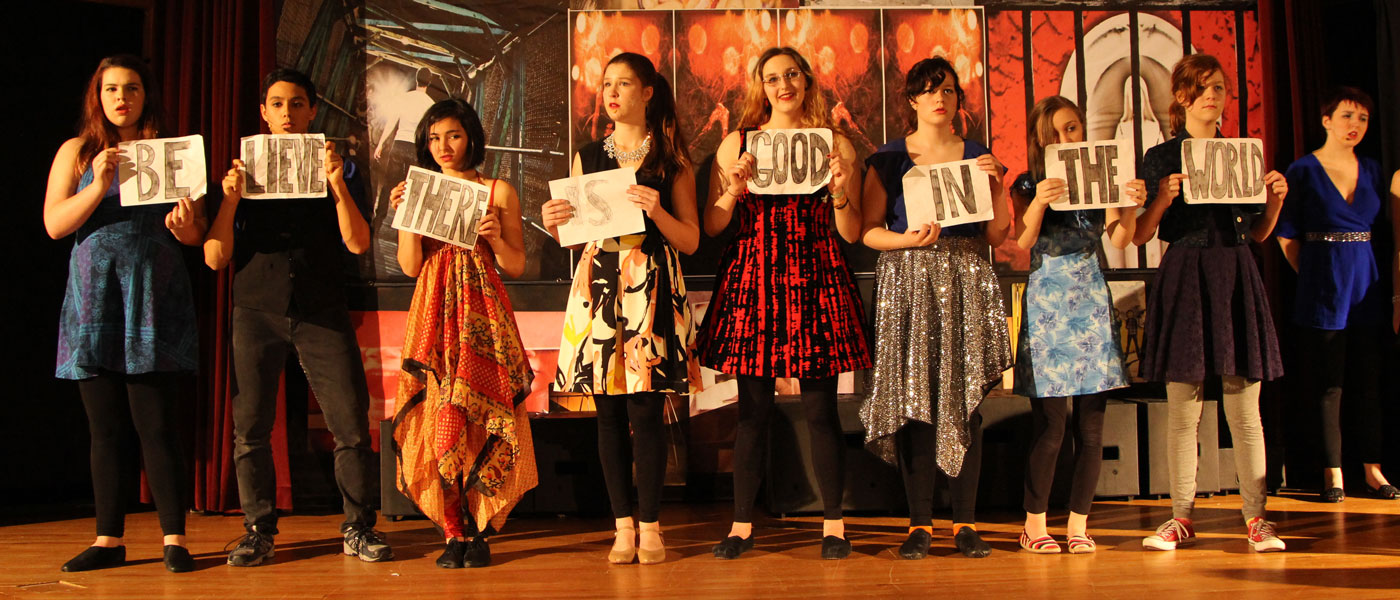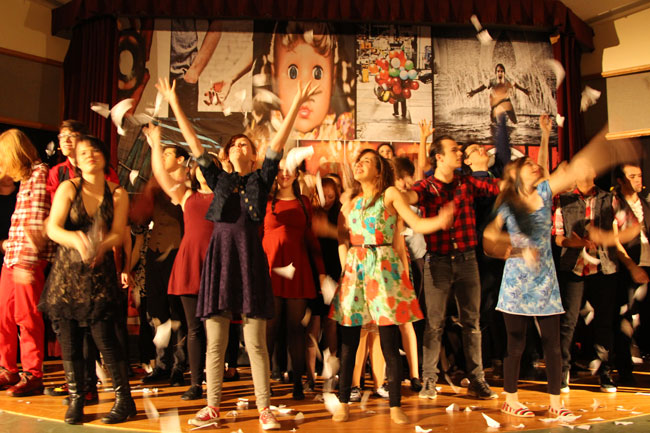
mages beget notions; notions beget ideas; ideas beget stories; stories beget sound worlds; sound worlds beget melodies and lyrics; melodies and lyrics beget images.
Most often, the creative inspiration for a piece of musical theatre is hidden from its audience behind its sets, costumes, lights, sounds, songs and dialogue. Drawings and design notes used to develop the soul of a production are shuffled away as rehearsals progress. Directors and designers, though, strive to make their inspiration come alive on stage and palpable to their audiences. Their ultimate goal is to bring to life the images in their minds developed long before an opening night, and to build the world of their ideas on stage.
Ryan Scott Oliver’s 35MM: A Musical Exhibition is “a multimedia musical” inspired by photographer Matthew Murphy’s images. This inspiration, Murphy’s works, refuses to recede into the storytelling of 35MM. They are meant to be openly displayed as a part of the show. Each of Murphy’s sixteen images pairs with its own song and adds layers of meaning. Some of Murphy’s photographs inspired Oliver’s songwriting, and some of Oliver’s songs were the impetus for Murphy’s images.
Credit: Almerinda Silva.
In March 2016, Innovation Academy Charter School in Tyngsborough, Massachusetts presented 35MM with an interesting twist from the start. 35MM is written for, and was originally performed by, five actors weaving themselves in and out of characters and motifs. By breaking the five-actor mold and casting 47 actors, director Rhonda Hawthorne created opportunities to craft each story as a distinct theatrical piece. Distinguishing lead roles from ensemble roles became impossible, as each song featured different singers. Hawthorne knew from the beginning stages of her planning that Innovation Academy’s 35MM would feature more actors than are explicitly called for. This gave her the opportunity to develop the show as a true ensemble piece. 35MM is especially suited to this type of exploration; maintaining consistent actors across songs is not necessary in this show, so many more actors can be featured than in most traditionally narrative musicals.
Samuel French offers guidelines for incorporating 35MM‘s images into performance, suggesting displaying images in a theater lobby or incorporating them into a printed program. Hawthorne decided that, in addition to their inclusion in the program, Murphy’s images would comprise the show’s set. Each image was enlarged and presented on a collaged backdrop, a standing flat, or on the face of a large block. This minimal set focused attention on Murphy’s images. Other than actors, the show’s photographs were the only visual information available to its audience. Creative inspiration was laid bare.
Credit: Almerinda Silva.
While 35MM contains themes that connect its songs to one another, it is not structured with a plot that spans the production. Audiences generate their own connections from song to song, inserting themselves in the creative process of the performance. The show is not, however, vague, leaving audiences to determine their own messages from nebulous lyrics. Rather, Oliver wrote with specificity so that each song feels like its own small show, telling its own story, from “On Monday” to “Leave Luanne” to “Cut You a Piece.”
Seemingly light and bubbly, “On Monday” relates one week in the beginning and possible ending of a relationship. A woman looking for a fling in a few days feels the pangs of a new partner wanting to move slowly. Over the course of a week, about four minutes of music, she discovers that she can forge a stronger connection by not rushing. But what she seems to want in this new relationship may not be what she will receive. Flirtation turns to introspection and uncertainty.
“Cut You a Piece” uses a balladeer to tell the story of a young couple in love whom tragedy hits. Alternating between continuing their story and functioning as the couple’s voices, the singer spins a tale of joy, sadness and redemption. The specificity of the story begs for telling the tale through live images created on stage. The inspiration of Murphy’s photograph layered with Oliver’s music continues the cycle of creation so that actors enrich the story and its image.
“Leave Luanne” weaves a harrowing tale of a battered and broken wife unable to escape what has become her life. The piece is structured in the style of a bluegrass murder ballad and is dubbed a “Southern Gothic Ghost Story” by Oliver. The Cajun and Les Voix un Dessous (“Voices from Under”) play out Luanne’s threatened survival on the Louisiana bayou. A woman cheered on by a stage filled with a gospel choir of an ensemble proves very powerful.
Credit: Almerinda Silva.
These characters will not reappear after their songs finish – 35MM does not allow for that. Separating the stories in his songs from each other, Oliver forces actors to dive deeply into characterization quickly, since from the beginning to the end of a song is all the time they have to embody their characters. There is no allowance in 35MM for anything left unclear to be cleaned up or further explained a few scenes later. 35MM has no later for any of its stories. They introduce themselves beautifully and then are gone. In this respect, Oliver’s goal was to make “[t]he experience of the show…part concert, part exhibition, part poetry jam, part performance art…” (Used Furniture Review, February 29, 2012)
Student involvement in the development of Innovation Academy’s 35MM was deep and not especially pre-planned. Knowing that each story told in the show is contained in one song gave the actors freedom to explore and create boldly. In a story told in a single song, each decision of character and movement and voice is magnified. Student decisions felt not like a small moment in a huge story, but like an integral part of the storytelling. Rather than this proving intimidating, students felt more free to explore and shift even late into the rehearsal process. A character choice had no ramifications later. It could exist in its own frame and flourish. Students felt ownership of their special piece of 35MM in ways they had not before experienced. The continuous creation of Oliver and Murphy’s work encouraged students to generate and add their own layers of meaning.
Art begat art.
To purchase a copy of 35MM: A Musical Exhibition, click here, and to learn more about licensing a production, click here.

Noël Coward’s Travels

Kate Chopin in New Orleans: Mother-Daughter Author Duo Collaborate on Historical Book




